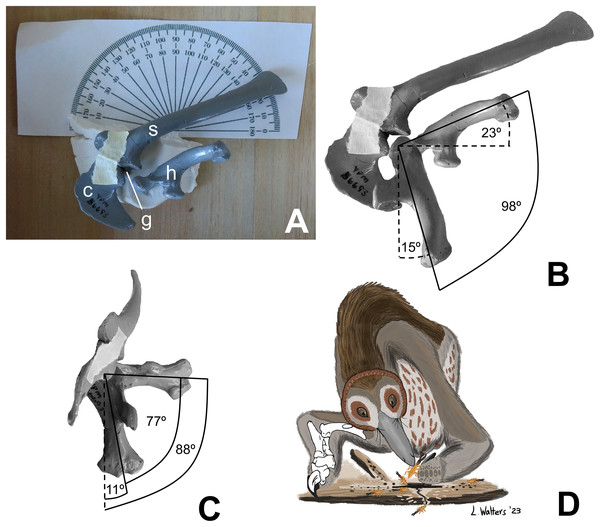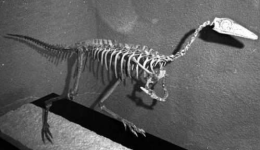Fred Ruhe
Well-known member

Philip J. Senter, 2023
Restudy of shoulder motion in the theropod dinosaur Mononykus olecranus (Alvarezsauridae)
PeerJ. 11. e16605. doi:10.7717/peerj.16605
Abstract and free pdf:

 peerj.com
peerj.com
Background: Range of motion in the forelimb of the Upper Cretaceous theropod dinosaur Mononykus olecranus, a member of the family Alvarezsauridae, has previously been investigated. However, the method used to investigate range of motion at the shoulder in M. olecranus did not follow the standardized procedure used in subsequent studies. The latter procedure yields more reliable results, and its standardization provides that its results are directly comparable to the results of similar studies in other species. I therefore reinvestigated the range of motion at the shoulder in M. olecranus, using the latter procedure.
Methods: Casts of the left scapula and coracoid of M. olecranus were posed on a horizontal surface, supported from beneath with modeling clay, with the medial surface of the scapula facing toward the horizontal surface. A cast of the left humerus was posed at the limits of motion through the transverse and parasagittal planes.
Photos of the poses in orthal views were superimposed and used to measure range of motion, which was measured as the angle between lines drawn down the long axis of the humerus in each position.
Results: Through the transverse plane, the humerus of M. olecranus could be elevated to a subhorizontal position and depressed to a subvertical position. It could move through the parasagittal plane from a subvertical position at full protraction to a position above the horizontal at full retraction. These results correct the previous mischaracterization of shoulder motion in M. olecranus as estricted to a small arc with the arms held in a permanent sprawl. The range of humeral motion in M. olecranus is much greater than that found by the previous method and allowed the animal to tuck its arms in at the sides, in addition to allowing them to sprawl so as to orient the palm downward. The wide range of humeral motion allowed M. olecranus to forage for insects by employing hook-and-pull digging at surfaces with a wider range of orientations than the previous study showed to be possible.
Enjoy,
Fred
P.S. The reason I mention this study is that Mononykus olecranus Altangerel Perle, Norell, Chiappe et Clark, 1993 is close to birds, so close that initialy it was described as a bird, in its own subclass and was much discussed in the 1990ies. finaly it was transferred from Aves to Theropada; Alvarezsauridae.
Mononykus olecranus Altangerel Perle, Norell, Chiappe et Clark, 1993

Ref:
Perle Altangrel, Mark A. Norell, Luis Chiappe & James M. Clark, 1993
Flightless Bird from the Cretaceous of Mongolia
Nature 362: 623-626 (see attachment)
Fred
Restudy of shoulder motion in the theropod dinosaur Mononykus olecranus (Alvarezsauridae)
PeerJ. 11. e16605. doi:10.7717/peerj.16605
Abstract and free pdf:

Restudy of shoulder motion in the theropod dinosaur Mononykus olecranus (Alvarezsauridae)
Background Range of motion in the forelimb of the Upper Cretaceous theropod dinosaur Mononykus olecranus, a member of the family Alvarezsauridae, has previously been investigated. However, the method used to investigate range of motion at the shoulder in M. olecranus did not follow the...
Background: Range of motion in the forelimb of the Upper Cretaceous theropod dinosaur Mononykus olecranus, a member of the family Alvarezsauridae, has previously been investigated. However, the method used to investigate range of motion at the shoulder in M. olecranus did not follow the standardized procedure used in subsequent studies. The latter procedure yields more reliable results, and its standardization provides that its results are directly comparable to the results of similar studies in other species. I therefore reinvestigated the range of motion at the shoulder in M. olecranus, using the latter procedure.
Methods: Casts of the left scapula and coracoid of M. olecranus were posed on a horizontal surface, supported from beneath with modeling clay, with the medial surface of the scapula facing toward the horizontal surface. A cast of the left humerus was posed at the limits of motion through the transverse and parasagittal planes.
Photos of the poses in orthal views were superimposed and used to measure range of motion, which was measured as the angle between lines drawn down the long axis of the humerus in each position.
Results: Through the transverse plane, the humerus of M. olecranus could be elevated to a subhorizontal position and depressed to a subvertical position. It could move through the parasagittal plane from a subvertical position at full protraction to a position above the horizontal at full retraction. These results correct the previous mischaracterization of shoulder motion in M. olecranus as estricted to a small arc with the arms held in a permanent sprawl. The range of humeral motion in M. olecranus is much greater than that found by the previous method and allowed the animal to tuck its arms in at the sides, in addition to allowing them to sprawl so as to orient the palm downward. The wide range of humeral motion allowed M. olecranus to forage for insects by employing hook-and-pull digging at surfaces with a wider range of orientations than the previous study showed to be possible.
Enjoy,
Fred
P.S. The reason I mention this study is that Mononykus olecranus Altangerel Perle, Norell, Chiappe et Clark, 1993 is close to birds, so close that initialy it was described as a bird, in its own subclass and was much discussed in the 1990ies. finaly it was transferred from Aves to Theropada; Alvarezsauridae.
Mononykus olecranus Altangerel Perle, Norell, Chiappe et Clark, 1993

Ref:
Perle Altangrel, Mark A. Norell, Luis Chiappe & James M. Clark, 1993
Flightless Bird from the Cretaceous of Mongolia
Nature 362: 623-626 (see attachment)
Fred
Attachments
Last edited:



